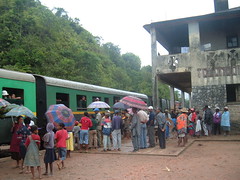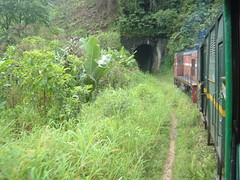My last mission of 2005, and I finally (after 6 months in Fianar) had my first opportunity to take a trip on the Fianarantsoa-Côte Est (FCE) train line that runs 163 km from Fianar to southeastern coastal city of Manakara. Unfortunately for this first trip I only got to go a few stops down the line before arriving at our mission site of Tolongoina, but the little that I saw sold me on trying more soon.
The passenger train leaves the Fianar station between 7 and 8 am on Tuesdays, Wednesdays, Thursdays, Saturdays and Sundays and consists of one or two first class cars and a similar number of second class. This time though, since it was lychee season, the number of passenger cars was reduced in favor of cargo cars for the unbelievable number of baskets of lychees being harvested from the orchards on the warm, summery coast.
I’ve often said that Madagascar is like a living museum. Here, metal plows pulled behind oxen for plowing and locally forged hand scythes for harvesting are high technology in the rice fields, so it wasn’t much of a surprise to learn that most of the parts of the FCE train line are hand-me-down technology. Most of the railroad ties and track are secondhand from various European countries and the engines and cars themselves are leftovers from when the track was first built in the French colonial days – and they were passed down from France even then. All-in-all, it gives the train a very antique feel, reminiscent of the (don’t laugh) renovated Camp 5 Logging Camp steam train in Lanoa, Wisconsin, that takes tourists into the Camp 5 logging camp and museum village. The feeling of stepping out of place and time into Old Town America is aided by the fact that first class is usually populated by tourists popping flashbulbs around every bend and gawking at the variety of local snacks being hawked at each stop.
But this train is the real thing. The distance it covers is not that long – only 30 km longer than the monthly trek I used to make from Bealanana to the bank in Antsohihy – yet it traverses some of the most rugged terrain in Madagascar as is drops from the Fianar elevation of 1100 meters to sea level. It also passes through Ranomafana forest corridor and provides access to the outside world for some of the most isolated communities living near and within this precious corridor. These communities use the train to transport the one commodity they have in abundance – green bananas. Without the train line, more than 100,000 people are left at the mercy of the forest…or, should I say, the forest is left at the mercy of the people desperate to eek out a living within it.
There are lots of spectacular views along the track, including the Sahambavy tea plantation and a HUGE waterfall just outside of the remaining forest corridor, as well as some very educational views of the impact of deforestation and unsustainable agricultural practices on the landscape outside of the corridor. The engineering in the track is extraordinary – the original construction was completed in 1936, at the expense of and unknowable number of Malagasy lives, but boasting 67 bridges and 48 tunnels, the longest over 1 km in length and just wide and tall enough for the FCE train cars.
We got off at the rundown colonial masterpiece of a station in Tolongoina, but I certainly hope to be able to take the train all the way to the coast one day soon. The future of the train is still (and always will be) tenuous as cyclones have done grave damage to the infrastructure the past; the
 Tolongoina Dec 13-14 (15)
Originally uploaded by ebrwstr.
Tolongoina Dec 13-14 (15)
Originally uploaded by ebrwstr. It’s only 163 km of track, but it’s 163 km well-worth the effort of protecting.

No comments:
Post a Comment